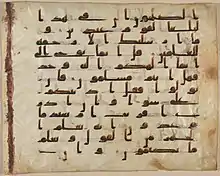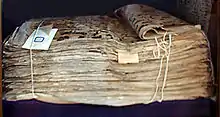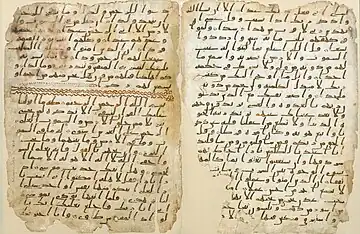Samarkand Kufic Quran
The Samarkand Kufic Quran (also known as the Uthman Quran, Samarkand codex, Samarkand manuscript and Tashkent Quran) is an 8th or 9th century manuscript Quran written in the territory of modern Iraq in the Kufic script. Today it is kept in the Hast Imam library, in Tashkent, Uzbekistan.

| Quran |
|---|
|
| Uthman The Generous (al-Ghani) |
|---|
.JPG.webp) |
|
It is said to have belonged to the third caliph, Uthman ibn Affan.[1]
Dating the Manuscript
Based on orthographic and palaeographic studies, the manuscript probably dates from the 8th or 9th century.[2][3] Radiocarbon dating showed a 95.4% probability of a date between 775 and 995.[3] However, one of the folios from another manuscript (held in the Religious Administration of Muslims in Tashkent) was dated to between 595 and 855 A.D. with a likelihood of 95%.[3]
History
The copy of the Quran is traditionally considered to be one of a group commissioned by the third caliph Uthman. According to Islamic tradition, in 651, 19 years after the death of the Islamic Prophet, Muhammad, Uthman commissioned a committee to produce a standard copy of the text of the Quran (see Origin and development of the Quran).[1] Five of these authoritative Qurans were sent to the major Muslim cities of the era, and Uthman kept one for his own use in Medina, although the Samarkand Quran is most likely not one of those copies. The only other surviving copy was thought to be the one held in Topkapı Palace in Turkey,[1][4] but studies have shown that the Topkapı manuscript is also not from the 7th century, but from much later.[5][6]
Uthman was succeeded by Ali, who is thought to have taken the uthmanic Quran to Kufa, now in Iraq. After Tamerlane captured that area seven centuries later he took it to his capital, Samarkand, as loot.[1] According to another, the Quran was brought from the ruler of Rum to Samarkand by Khoja Ahrar, a Turkestani sufi master, as a gift after he had cured the ruler.
The Quran remained in the Khoja Ahrar Mosque of Samarkand for four centuries until 1869, when the Russian general Abramov bought it from the Imams of the mosque and gave it to Konstantin von Kaufman, Governor-General of Turkestan, who in turn sent it to the Imperial Library in Saint Petersburg (now the Russian National Library).[1] It attracted the attention of Orientalists and eventually a facsimile edition was published in Saint-Petersburg in 1905. The 50 copies soon became rarities. The first thorough description and dating of the manuscript was undertaken by the Russian Orientalist Shebunin in 1891.
After the October Revolution, Vladimir Lenin, in an act of goodwill to the Muslims of Russia, gave the Quran to the people of Ufa, Bashkortostan. After repeated appeals by the people of the Turkestan ASSR, the Quran was returned to Central Asia, to Tashkent, in 1924, where it has since remained.[1]
Current state

The parchment manuscript now is held in the library of the Telyashayakh Mosque, in the old "Hast-Imam" (Khazrati Imom) area of Tashkent, close to the grave of Kaffal Shashi, a 10th-century Islamic scholar.
A folio containing a page from the sura Al-Anbiya is held at the Metropolitan Museum of Art in New York City, US.
The manuscript is incomplete:[1] it begins in the middle of verse 7 of the second sura and ends at Surah 43:10. The manuscript has between eight and twelve lines to the page and, showing its antiquity, the text is devoid of vocalisation.
See also
References
- Ian MacWilliam (2006-01-05). "Tashkent's hidden Islamic relic". BBC News. Retrieved 2010-05-27.
- "The "Qur'ān Of ʿUthmān" At Tashkent (Samarqand), Uzbekistan, From 2nd Century Hijra". Retrieved 5 September 2013.
- E. A. Rezvan, "On The Dating Of An “'Uthmanic Qur'an” From St. Petersburg", Manuscripta Orientalia, 2000, Volume 6, No. 3, pp. 19-22.
- Ariffin, Syed Ahmad Iskandar Syed (19 June 2017). Architectural Conservation in Islam: Case Study of the Prophet's Mosque. Penerbit UTM. ISBN 9789835203732 – via Google Books.
- "Corpus Coranicum". corpuscoranicum.de.
- "Al-Mushaf Al-Sharif Attributed to 'Uthman bin 'Affan". www.ircica.org. Archived from the original on 2014-01-05.
External links
- W. Ouspensky, S. Pissaref, ed. (1905). Coran coufique de Samarcand (facsimile) = Самаркандский куфический Коран (факсимиле). St. Pétersbourg: Institut Archéologique de St. Pétersbourg.
- Самаркандский куфический Коран (in Russian). RARUS'S GALLERY. Retrieved 26 September 2012.
- "Memory of the World Register - Nomination Form Uzbekistan - Holy Koran Mushaf of Othman" (PDF). UNESCO. Retrieved 26 September 2012.
